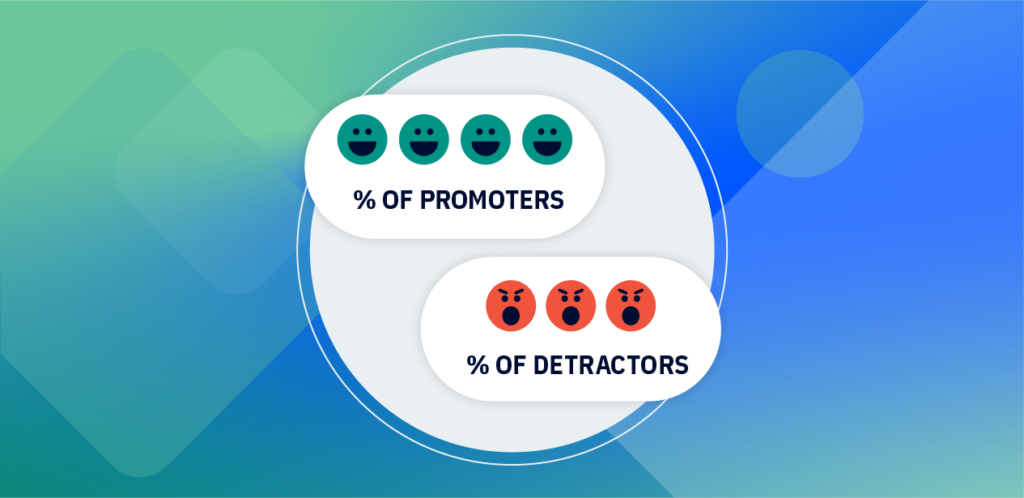Author: David Ensing, Ph.D., Vice President, Solutions Strategy
What is NPS?
In 2003, Fred Reichheld introduced the Net Promoter Score (NPS) as the “one number you need to grow” within the customer experience (CX) field. Since that time, many companies have adopted this measure. At InMoment, we are often asked about our perspective on using NPS versus other CX metrics, NPS advantages and disadvantages, and its proper use cases. So to answer these common questions, we’ve pulled together a brief overview on NPS. Let’s break it down!
How is NPS Calculated?
As a review, NPS uses a standard question, a standard response scale, and a standard scoring technique. The question is “how likely is it that you would recommend Company X to a friend or colleague?”
The response scale ranges from 0 (labeled as “Not at all likely”) to 10 (labeled as “Extremely likely”). The score itself is calculated at the aggregate level and is the percentage of respondents who select 10 or 9 (defined as Promoters) minus the percentage of respondents who select 6 or below (defined as Detractors). Therefore, an NPS score can range from +100 to -100.
NPS is About Company Growth, Not Just Customer Loyalty
Because Fred Reichheld promotes the importance of customer loyalty, NPS is commonly thought of as a customer loyalty metric. However, Reichheld points out in his book, The Ultimate Question, that NPS is a measure intended to predict companies’ growth. He specifically states: “All this number crunching had one goal in mind: to determine which survey questions showed the strongest statistical correlation with repeat purchases and referrals. We hoped to find for each industry at least one question that effectively predicted what customers would do and hence helped predict a company’s growth.” (pg. 27)
Using NPS as a loyalty measure alone was never the intention, as it was initially meant to inform businesses largely about company growth rather than customer loyalty. To further drive home this point, Reichheld’s book is subtitled “Driving Good Profits and True Growth.”
What are the Advantages of NPS?
Originally, the promise of NPS was to be the best predictor of company growth across industries (not customer loyalty as is commonly assumed). Since the publication of Reichheld’s HBR article and subsequent book, many studies have disputed this claim. Most CX practitioners seem to view NPS as similar to many other CX metrics, such as Overall Satisfaction (CSAT), Customer Effort Score (CES), or the traditional “Big 3” index of Overall Satisfaction, Likelihood to Recommend, and Likelihood to Return/Repurchase.
The biggest advantage in using NPS is that it has gained wide acceptance within the CX industry. It’s often used as a benchmarking measure for companies, both within and across industries. NPS can also help brands adopt an easy-to-understand, common language by giving them one singular metric to keep track of, so it’s a good way to begin for companies just starting out in customer experience.’
What to Keep in Mind When Using NPS
The greatest advantage of using NPS is its benchmarking capabilities. But for NPS scores to be comparable, consistently asking the question is key. Not only does the question, response scaling, and scoring need to be consistent, other factors need consistency as well:
Who is Responding?
NPS is generally used to measure a company’s current customers’ perceptions of the company. Scores from respondents that contain other consumer groups (e.g., lost customers, consumers who know of but are not customers of the company) are not comparable.
What is the Context?
NPS is a customer relationship measurement. So, the NPS question should be used in customer relationship surveys rather than post-transaction surveys. If the NPS question is asked in transaction-based surveys, the outcomes of the transactions will affect the NPS score. For example, even when asking the same brand NPS question, we always find lower NPS scores when it is asked in an automotive repair survey than when it is asked in an automotive sales survey.
Cultural Factors
The NPS question is not immune to cultural factors and other biases that affect survey measures. For instance, respondents from certain cultural backgrounds are more likely to give top-box scores, which is why comparing NPS scores across cultures and languages is discouraged.
Question Placement:
Where the question is placed within a survey should also be considered. It’s better to place the question early in a survey so it’s a “top of mind” measure instead of late in a survey where it will act more as a “considered response” measure.
Additional Intelligence is Needed
NPS can give you a good idea of “how” your company is doing compared to others, but it won’t give you any idea of “what” your company is doing right or wrong in your CX efforts. For that reason, NPS should not be used alone. It should be used in conjunction with key diagnostic questions (both closed-ended and open-ended) to determine areas for improvement and alongside other CX metrics (CSAT, CES) etc.
Add a Closed-Loop Program:
Many companies conduct customer surveys to identify and follow-up with at-risk customers. Just measuring NPS will not help you accomplish this. In most cases, you should implement a robust closed-loop program in your NPS survey. We recommend contacting as many detractors as possible to resolve their problems the best you can, but don’t forget about the people who rated you seven or eight (Passives). Usually, Passives can be converted to Promoters much more easily than Detractors.
As noted in Fred Riechheld’s book, NPS was the best predictor of growth across all industries, but it was not the best predictor in each industry. He states: “In eleven of fourteen cases, this question ranked first or second. In two of the other three, it was so close to the top that it could serve as a proxy for those that did rank number one or number two.” (pg. 28) While not reported, it’s also likely that NPS was not the best predictor of growth for each company.
Define Metric Outcome Needs
NPS may not be the best metric to use if you are trying to drive specific outcomes rather than using it solely for comparative purposes. NPS is generally less useful for predicting key outcomes within a particular company for two reasons. First, as Reichheld noted in his book The Ultimate Question, NPS was the best predictor of growth across all industries, but it was not the best predictor in each industry (see sidebar). Second, while company growth is an important outcome metric, it can be far removed from the customer experience because other factors (e.g., effective marketing, financial management, charismatic leadership, etc.) also affect company growth. Often, a better approach is to define the customer outcome variable you are most interested in affecting (e.g., customer advocacy, transactional customer satisfaction, repeat purchasing, etc.) and conduct linkage analysis to determine the best and most important predictors of that variable for your company.
Finally, companies that merely scoreboard-watch their NPS as it moves without analyzing why it’s moving won’t find it effective. The same applies for any other metric. Whichever metric(s) companies use, the truth is that brands must tackle the difficult challenge of understanding the relationship between a key customer metric (NPS, CSAT, etc.), and the business outcomes they want to accomplish. Taking the time to think through and design a CX program in advance helps brands understand which metrics suit their business and customer needs best.
You can download the full PoV as a PDF by clicking the button below!
Download


